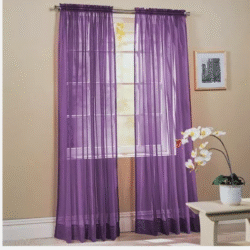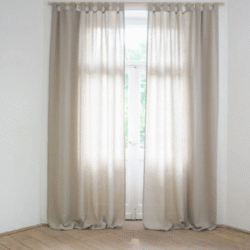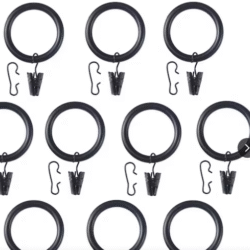home curtains are an essential part of interior design, offering both functional and aesthetic benefits to any living space. They not only provide privacy and light control but also serve as a key element in enhancing the overall decor of a room. The choice of fabric, color, and style can dramatically influence the mood and ambiance of a space, making curtains an important consideration for homeowners and designers alike. This essay will explore the various types of home curtains, their practical uses, and how they contribute to the beauty and comfort of a home.
Choosing the Right Fabric for Your Curtains
Choosing the right fabric for your curtains is crucial in achieving the desired look and functionality for your home. The fabric you select can influence the room’s ambiance, offer privacy, control light, and provide insulation. When choosing fabric, consider factors like texture, color, durability, and the amount of light you want to let in.
- Light Control: If you’re aiming for maximum light-blocking, heavy fabrics like velvet, brocade, or blackout materials are excellent choices. These fabrics are thick and provide effective insulation, keeping your room cooler in the summer and warmer in the winter.
- Aesthetic Appeal: For a light, airy feel, consider fabrics like linen, cotton, or sheer materials. These fabrics allow natural light to filter through, creating a soft, glowing effect, while still offering some privacy. Sheer curtains, in particular, are perfect for bright spaces where you want to maintain a sense of openness.
- Durability and Maintenance: Heavier fabrics, such as polyester or blends, are often more durable and easier to maintain than delicate materials like silk or linen. Polyester is also more resistant to fading, making it a great option for sunlit rooms.
- Color and Pattern: The fabric’s color and pattern should complement the overall decor of the room. Neutral tones like whites, grays, or earth tones provide versatility, while bold colors or patterns can serve as a statement piece.
In summary, selecting the right fabric for your curtains depends on both practical needs and aesthetic preferences, ensuring that your curtains are not only functional but also enhance the beauty of your space.
home curtains Popular Curtain Styles for Every Room
Curtains play a vital role in defining the style and atmosphere of any room, and the right curtain style can enhance the overall decor. Whether you’re aiming for a classic look, modern appeal, or something in between, there are numerous curtain styles to consider for every room in your home.
- Sheer Curtains: Ideal for living rooms or dining areas, sheer curtains allow natural light to flood the room while providing privacy. They create an airy, soft atmosphere, making the space feel more open and inviting. Pair sheer curtains with heavier drapes or blinds for added versatility.
- Grommet Curtains: These curtains feature metal rings at the top, making them easy to slide along a curtain rod. Their sleek, modern look makes them perfect for contemporary or minimalist spaces. Grommet curtains are versatile, working well in bedrooms, living rooms, and even offices.
- Tab-Top Curtains: Known for their casual and relaxed style, tab-top curtains are a great choice for spaces like kitchens or cozy living rooms. The fabric is hung on fabric loops at the top of the curtain, creating a laid-back, rustic vibe.
- Pleated Curtains: For a more formal or traditional look, pleated curtains offer elegance and sophistication. Whether you opt for pinch pleats, box pleats, or accordion pleats, these curtains add structure and a touch of luxury to dining rooms, bedrooms, or formal living areas.
- Roman Shades: Offering a streamlined and tailored look, Roman shades are perfect for bedrooms or home offices. When raised, they fold neatly into horizontal pleats, making them an excellent choice for rooms where you want a more refined, clean appearance without the bulk of traditional curtains.
- Blackout Curtains: For bedrooms, nurseries, or home theaters, blackout curtains are a must-have. Made from thick, opaque fabric, they block out light completely, creating a dark and serene environment perfect for sleeping or watching movies.
- Café Curtains: Typically hung at the halfway point of a window, café curtains are great for kitchens, bathrooms, or other spaces where you want some privacy without covering the entire window. They provide a charming, vintage look and allow light to filter in from the top while maintaining privacy at eye level.
- Bi-Fold or Sliding Door Curtains: For larger windows or patio doors, bi-fold or sliding door curtains are practical yet stylish. These curtains are designed to slide easily to the side, allowing for easy access to the outdoors while offering a beautiful framing effect.
Choosing the right curtain style for each room depends on the desired level of privacy, light control, and the overall aesthetic you want to achieve. Whether you’re looking for something bold and dramatic or soft and subtle, there’s a curtain style to suit every space.
How to Measure for Perfectly Fitting Curtains
Measuring for perfectly fitting curtains is essential to achieving a polished, professional look in any room. Accurate measurements ensure that your curtains hang correctly and provide the desired level of coverage and light control. Here’s a step-by-step guide on how to measure for curtains:
Measure the Width of Your Window
- For Curtain Rod Placement: To ensure your curtains cover the window fully and create a
- more expansive look, measure the width of your window, and then add extra width to
- allow for the curtains to overlap in the center. This extra width is typically 4 to 8 inches
- on each side, depending on how full you want the curtains to appear.
- For Ready-Made Curtains: If you’re using ready-made curtains, be sure to check the
- listed width to ensure it’s suitable for your window size. A common rule is that the width
- of the curtains should be about 1.5 to 3 times the width of the window for a fuller look.
Measure the Length of Your Curtains
- From the Rod to the Floor: For a traditional look, curtains should hang just below the
- window frame. To measure: Start at the top of the window frame or the curtain rod and measure straight down to the floor.
- For a more dramatic effect, measure 1 to 2 inches above the floor so the curtains just
- graze it, or allow them to pool slightly on the floor for an elegant, luxurious look.
For Different Styles:
- Sill-length curtains: Measure from the rod to the window sill.
- Floor-length curtains: Measure from the rod to the floor, usually at least 1 inch above the floor to avoid dragging.
- Puddle-length curtains: Allow extra fabric to fall onto the floor, creating a puddle effect. Measure longer if you prefer this look.
Consider the Curtain Rod Height
The position of your curtain rod can significantly impact the final look of the curtains. Typically, curtain rods are installed 4 to 6 inches above the window frame, but for a more dramatic, elongated look, you may want to install the rod closer to the ceiling.
Measure the Distance: If the rod is already installed, measure from the top of the rod (where the curtains will hang) to the floor, ensuring your curtains will have the desired length.
Account for Curtain Header Style
If you’re using a specific header style (like grommet, pleated, or tab-top curtains), keep in mind that the fabric will hang differently, depending on the header’s depth. Measure the drop from the top of the header to the floor to ensure proper length. Double-Check Your Measurements It’s always a good idea to measure twice to ensure accuracy. Measure at different points across the width and length of the window, especially if your walls or windows are uneven.
Adjust for Curtain Type
Depending on whether you’re choosing curtains with pleats, grommets, or other finishes, you may need to adjust your measurements slightly. Pleated curtains, for example, will require more fabric than flat-panel curtains, so add extra width and height as needed.By following these steps, you can ensure your curtains fit perfectly, adding both functionality and beauty to your home. Proper measurements are the key to creating the ideal window treatment that enhances your room’s decor.
The Best Curtain Rods and Accessories for Your Home
Choosing the right curtain rods and accessories is essential for enhancing the overall appearance and functionality of your curtains. The perfect combination not only supports the curtains but also contributes to the style of your room. Here are some of the best curtain rods and accessories to consider for your home:
Best Curtain Rods
- Adjustable Curtain Rods: These rods are versatile and ideal for windows of varying sizes. Adjustable rods can be expanded or contracted to fit different window widths, making them a popular choice for most homes.
- Decorative Rods: For a more polished, decorative look, opt for rods with intricate finials (the end pieces of the rod). These rods come in a variety of styles, such as traditional, modern, or vintage, and can be made from materials like wood, metal, or wrought iron.
- Double Curtain Rods: These are great for layered window treatments, such as combining sheer curtains with heavier drapes. A double curtain rod allows you to hang two sets of curtains at once, providing greater flexibility in light control and privacy.
- Tension Rods: Ideal for smaller or temporary window treatments, tension rods are easy to install without drilling. They’re perfect for bathrooms, kitchens, or rental spaces where permanent installation isn’t an option.
- Industrial-Style Rods: For a modern or rustic look, consider industrial-style curtain rods made from metal pipes or other raw materials. These rods add an urban, minimalistic touch to your space.
Curtain Rod Accessories
- Finials: Finials are the decorative ends of the curtain rod that add personality and style. They come in various shapes and sizes, from simple round balls to intricate designs like flowers, spheres, or geometric shapes. Choose a finial that matches your room’s aesthetic, whether it’s sleek and minimal or ornate and classical.
- Bracket Sets: Brackets hold the curtain rod in place. They come in different finishes and styles to match your chosen rod. Ensure the brackets are sturdy enough to support the weight of your curtains, especially for heavy or layered drapes.
- End Caps: For a more understated look, end caps provide a simple and sleek finish to curtain rods. These are perfect if you prefer a clean, minimalistic style without any added decoration.
- Curtain Rings: If you choose curtains with hooks, curtain rings are essential. These allow the curtains to slide smoothly across the rod, preventing any fabric bunching or pulling. They are available in a variety of materials, including wood, metal, and plastic.
- Tiebacks: Tiebacks are a practical accessory for holding curtains open. Available in various styles, including rope, tassels, and metal or fabric hooks, tiebacks can add an elegant touch while allowing for better light control when needed.
- Rod Extenders: If your window is particularly wide, rod extenders can help provide extra support and ensure the rod spans the full length. These accessories are helpful in preventing the rod from sagging or bending under the weight of heavy curtains.
Choosing the Right Materials and Finishes
- Wooden Rods: Wooden rods are perfect for traditional or rustic-themed rooms. They add warmth and texture, and their natural finish complements various decor styles.
- Metal Rods: For a modern or industrial vibe, metal rods in materials like brass, chrome, or matte black provide a sleek and sophisticated look. They are durable and complement a wide range of curtain fabrics.
- Brushed Nickel or Bronze Finishes: These finishes are timeless and versatile, blending easily into contemporary, traditional, or transitional spaces. They also resist corrosion, making them perfect for areas like bathrooms.
- Gold and Silver Finishes: For an opulent touch, gold or silver curtain rods and accessories add luxury and refinement. These finishes work well in more formal or elegant spaces.
Practical Considerations
- Weight Capacity: Always choose rods and accessories that can support the weight of your curtains. Heavy drapes may require a sturdier rod and brackets, while lighter fabrics can be paired with more delicate setups.
- Easy Installation: Look for rods and brackets that are easy to install and come with the necessary mounting hardware. Some rods also come with a mounting template for accurate placement.
Consider Your Room’s Aesthetic
- Modern/Minimalist: Opt for simple, sleek curtain rods in neutral finishes like matte black or brushed nickel. Pair them with clear glass or metal finials to maintain the minimalist look.
- Traditional/Classic: Choose ornate rods with decorative finials, such as wooden rods with carved detailing or gold-tone finishes, to complement classic interior design elements.
- Bohemian/Coastal: For a relaxed, eclectic vibe, choose natural wood rods, woven or braided tiebacks, and flowing, lightweight curtains that capture a breezy, coastal feel.
Read also:
Conclusion
The right curtain rods and accessories can elevate the look of your curtains while also providing functional support. Whether you prefer a bold, decorative rod or a sleek, minimalistic design, selecting the best combination for your home will enhance your window treatments and complement your overall decor.




